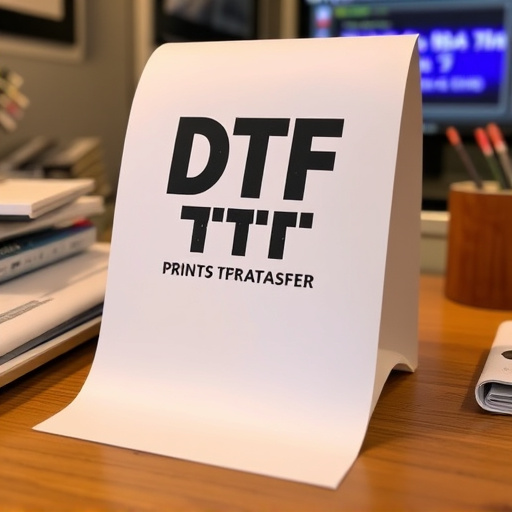Direct-to-film (DTF) printing offers a revolutionary way to create high-quality visuals on various surfaces. To start, gather essential materials like DTF transfer film, UV printer, cleaning supplies, and protective gear. Ensure your artwork is high resolution and in compatible formats. Prepare substrates by cleaning and pre-treating fabrics. Select appropriate DTF ink, design or source images, print onto the film, apply heat and pressure, then cure the transfer. After curing, heat sets the ink permanently for sharp details. Proper post-processing involves allowing ink to cure fully, gentle cleaning, maintaining a dust-free environment, and protecting prints from direct sunlight. DTF is ideal for custom clothing, accessories, and decorative items.
“Unleash your creativity with Direct-to-Film (DTF) printing—a game-changing technique for achieving vibrant, durable prints on a variety of surfaces. This comprehensive guide offers step-by-step instructions to master DTF transfer. From understanding the basics and gathering materials to preparing designs and curing prints, we’ll navigate you through the process. Learn how to apply DTF on diverse substrates, ensuring optimal quality and longevity. Discover tips for post-processing and maintenance to preserve your stunning DTF creations.”
- Understanding Direct-to-Film (DTF) Transfer: A Brief Overview
- Gathering the Necessary Materials and Equipment
- Preparing Your Design for DTF Printing: Tips and Tricks
- Step-by-Step Application of DTF Transfer on Various Substrates
- Curing and Heating Processes for Optimal Print Quality
- Post-Processing and Maintenance for Longevity of DTF Prints
Understanding Direct-to-Film (DTF) Transfer: A Brief Overview

Direct-to-film (DTF) transfer is a cutting-edge printing technique revolutionizing the way we create and reproduce visuals directly onto various surfaces, especially in the realm of DTF prints. This method eliminates the need for intermediate steps, such as printing on paper or vinyl, and allows for precise, high-quality imaging directly onto materials like fabric, metal, and wood.
DTF involves using specialized printers that deposit dye or pigment directly onto the substrate, enabling vibrant, lasting colors and intricate detail. The process ensures a seamless fusion of design and material, making DTF prints ideal for a range of applications, from custom clothing and accessories to signage and decorative items. Understanding DTF transfer is crucial when embracing this technology for your creative projects, as it offers both efficiency and exceptional visual outcomes.
Gathering the Necessary Materials and Equipment

Before diving into the direct-to-film (DTF) print process, ensure you have all the necessary materials and equipment. This includes a DTF transfer film—a special type of vinyl that allows for precise image transfer onto various surfaces—along with a DTF printer, which uses UV light to cure the ink and fix the design onto the medium. Additionally, you’ll need a clean, flat surface for printing, such as a glass table or a dedicated print bed.
Gather high-quality DTF prints suitable for your project, along with cleaning supplies like isopropyl alcohol and microfiber cloths to ensure optimal results. Don’t forget protective gear, like gloves, to prevent ink exposure. With these essentials in hand, you’re ready to embark on the DTF printing journey, creating vibrant, durable designs that can transform a variety of surfaces into true works of art.
Preparing Your Design for DTF Printing: Tips and Tricks

Preparing your design for Direct-to-Film (DTF) printing involves a few key steps to ensure optimal results. Start by ensuring your artwork is in high resolution, typically 300 dpi or higher, as this will allow for crisp and detailed prints. The file format should be compatible with DTF printers, commonly CMYK or SVG.
Next, consider the color profile of your design. Since DTF transfers use a heat process to bond ink to the substrate, it’s crucial to choose colors that are suitable for this method. Avoid vibrant or intense colors as they may not transfer evenly. Instead, opt for solid colors and subtle gradients for the best DTF prints. Additionally, make sure your design is properly scaled and centered to fit the desired print area, as misalignment can lead to imperfect results.
Step-by-Step Application of DTF Transfer on Various Substrates

Direct-to-film (DTF) transfer is a versatile method for applying prints to various substrates, from t-shirts to mugs and more. Here’s a step-by-step guide for achieving crisp, high-quality DTF results:
1. Prepare Your Substrate: Start by cleaning and preparing your substrate. Ensure it’s free of oils, dirt, or any other contaminants that might interfere with the print adhesion. For fabric, consider pre-treating with a suitable fabric preparer to enhance printability.
2. Choose the Right DTF Ink and Film: Select a DTF ink compatible with your printer and the substrate material. Ensure you use high-quality DTF film designed for optimal transfer. Different inks and films may have specific recommendations for heating, pressure, and time, so always follow manufacturer guidelines.
3. Design and Print Your Image: Design or source an image suitable for DTF printing. Use graphic design software to create your art or import a high-resolution image. Ensure the design is in a format compatible with your printer. Print the design directly onto the DTF film using your printer’s highest quality setting.
4. Apply Heat and Pressure: Preheat your substrate according to the DTF ink manufacturer’s instructions, typically between 175°F-200°F (80°C-93°C). Once preheated, place the printed DTF film face down on the substrate and apply pressure using a heat press or iron. Maintain pressure for the recommended time, usually 15-30 seconds, to ensure a strong bond between the ink and the substrate.
5. Cool and Cure: Remove the heat source and allow the transfer to cool completely. Some inks may require curing under specific conditions, such as exposure to UV light or air drying, before handling. Follow the manufacturer’s instructions for optimal curing to prevent smudging or peeling.
Curing and Heating Processes for Optimal Print Quality

After applying the DTF transfer to your substrate, curing and heating become crucial steps in ensuring optimal print quality for your DTF prints. The curing process involves exposing the ink to specific light conditions, typically UV or LED, which initiate a chemical reaction that hardens the ink, making it durable and water-resistant. This step is essential for achieving sharp details and vibrant colors in your DTF prints.
The heating process further improves print quality by setting the ink permanently onto the substrate. Different materials may require varying temperature settings and heating times. Precise control of both curing and heating parameters, such as intensity, duration, and temperature, allows for fine-tuning the final appearance of your DTF prints, ensuring they meet your desired standards.
Post-Processing and Maintenance for Longevity of DTF Prints

After completing the DTF transfer process, proper post-processing and maintenance are crucial to ensure the longevity of your prints. The first step is allowing the ink to cure completely. This usually involves leaving the printed item flat for a specific duration recommended by the manufacturer. During this time, avoid handling the print to prevent smudging or damaging the delicate ink layer. Once cured, gently clean the DTF print with a soft cloth and mild detergent to remove any residue or fingerprints. Be sure not to use harsh chemicals or abrasive materials that could damage the print.
Regular maintenance involves keeping your DTF prints in a dust-free environment and protecting them from direct sunlight, as it can cause the colors to fade over time. Consider framing or laminating sensitive prints for added protection. Additionally, store your DTF works properly when not in use to prevent creasing or warping. With proper care, DTF transfers can last for years, preserving the vibrancy of images and text for future reference and enjoyment.














